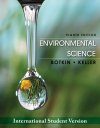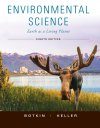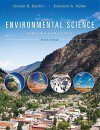About this book
Environmental Science: Earth as a Living Planet, Eighth Edition provides emphasis on the scientific process throughout the book gives readers the structure to develop their critical thinking skills. Updated and revised to include the latest research in the field, the eighth edition continues to present a balanced analytical and interdisciplinary approach to the field. New streamlined text clears away the "jargon" to bring the issues and the science to the forefront. The new design and updated image program highlights key points and makes Environmental Science: Earth as a Living Planet easier to navigate.
New to this edition:
- The eighth edition offers 24 Chapters, (the seventh edition was 29 chapters)
- New streamlined text clears away the “jargon” to bring the issues and the science to the forefront.
- New Chapter 24: Our Environmental Future provides a capstone chapter for the course. Data and research has been updated to provide the most up-to-date information in the field.
Contents
Chapter 1 Key Themes in Environmental Science
Chapter 2 Science as a Way of Knowing: Critical Thinking about the Environment
Chapter 3 The Big Picture: Systems of Change
Chapter 4 The Human Population and The Environment
Chapter 5 Ecosystems: Concepts and Fundamentals
Chapter 6 The Biogeochemical Cycles
Chapter 7 Dollars and Environmental Sense: Economics of Environmental Issues
Chapter 8 Biological Diversity and Biological Invasions
Chapter 9 Ecological Restoration
Chapter 10 Environmental Heath, Pollution, and Toxicology
Chapter 11 Agriculture, Aquaculture, and the Environemnt
Chapter 12 Landscapes: Forests, Parks, and Wilderness
Chapter 13 Wildlife, Fisheries, and Endangered Species
Chapter 14 Energy: Some Basics
Chapter 15 Fossil Fuels and the Environment
Chapter 16 Alternative Energy and the Environment
Chapter 17 Nuclear Energy and the Environment
Chapter 18 Water Supply, Use, and Management
Chapter 19 Water Pollution and Treatment
Chapter 20 The Atmosphere, Climate, and Global Warming
Chapter 21 Air Pollution
Chapter 22 Urban Environments
Chapter 23 Materials Management
Chapter 24 Our Environmental Future
Appendix
Glossary
Notes
Photo Credits
Index
Customer Reviews
Biography
Daniel B. Botkin is President of The Center for the Study of Environment and Professor Emeritus of Ecology, Evolution and Marine Biology, University of California, Santa Barbara. From 1978 to 1993, he was Professor of Biology and Environmental Studies at the University of California, Santa Barbara, serving as Chairman of the Environmental Studies Program from 1978 to 1985. For more than three decades, Professor Botkin has been active in the application of ecological science to environmental management. He is the winner of the Mitchell International Prize for Sustainable Development and the Fernow Prize for International Forestry, and he has been elected to the California Environmental hall of Fame. Trained in physics and biology, Professor Botkin is a leader in the application of advanced technology to the study of the environment. The originator of widely used forest gap models, his research has involved endangered species, characteristics of natural wilderness areas, the study of the biosphere, and attempts to deal with global environmental problems. During his career, Professor Botkin has advised the World Bank about tropical forests, biological diversity, and sustainability, the Rockefeller Foundation about global environmental issues, the government of Taiwan about approaches to solving environmental problems; and the state of California on the environmental effects of water diversion on Mono Lake. He served as the primary advisor to the National Geographic Society for their centennial edition map on The Endangered Earth. He recently directed a study for the states of Oregon and California concerning salmon and their forested habitats. He has published many articles and books about environmental issues. His latest books are Beyond the Stoney Mountains: Nature in the American West from Lewis and Clark to Today (Oxford University Press), Strange Encounters: Adventures of a Renegade naturalist (Penguin/Tarcher), The Blue Planet (Wiley), Our Natural History: The Lessons of Lewis and Clark (Putnam), Discordant Harmonies: A New Ecology for the 21st Century (Oxford University Press), and Forest Dynamics: An Ecological Model (Oxford University Press). Professor Botkin was on the faculty of the Yale School of Forestry and Environmental Studies (1968 1974) and was a member of the staff of the Ecosystems Center at the Marine Biological Laboratory, Woods Hole, MA (1975 1977). He received a B.A. from the University of Rochester, an M.A. from the University of Wisconsin, and a Ph.D. from Rutgers University.
Edward A. Keller was Chair of the Environmental Studies and Hydrologic Sciences Programs from 1993 to 1997 and is Professor of Geological Sciences at the University of California, Santa Barbara, where he teaches geomorphology, environmental geology, environmental Science, river processes, and engineering geology. Prior to joining the faculty at Santa Barbara, he taught geomorphology, environmental studies, and earth science at the University of North Carolina, Charlotte. He was the 1982 1983 Hartley Visiting Professor at the University of Southampton and a Visiting Fellow in 2000 at Emmanuel College of Cambridge University, England. Professor Keller has focuses his research efforts into three areas: Studies of Quaternary stratigraphy and tectonics as they relate to earthquakes, active folding, and mountain building processes; hydrologic process and wildfire in the chaparral environment of southern California; and physical habitat requirements for the endangered southern California steelhead trout. He is the recipient of various Water Resources Research Center grants to study fluvial processes and U.S. Geological Survey and Southern California Earthquake Center grants to study earthquake hazards. Professor Keller has published numerous papers, and is the author of the textbooks Environmental Geology, Introduction to Environmental Geology and (with Nicholas Pinter) Active Tectonics (Prentice Hall). He holds bachelors degrees in both geology and mathematics from California State university, Fresno; an M.S. in geology from the University of California; and a Ph.D. in geology from Purdue University.




































